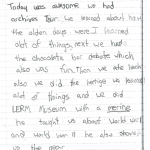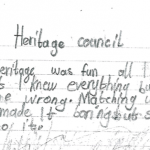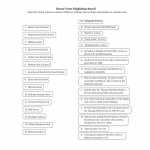We are surrounded by names.
Our friends have names. Our streets and our neighbourhoods have names. Our schools and our buildings have names. The word for the name of a specific place or space is a toponym. While I’m not a toponymist (someone who studies place names professionally), I understand that these names are laden with the stories, people, places, and social systems surrounding them.
The Edmonton Heritage Council was recently visited by City Hall School students from Mill Woods. Mill Woods has no shortage of names steeped with meaning. These students, for example, came from Sakaw School, which is a Cree word for “wooded area”.
- Reflections from City Hall School students
- Reflections from City Hall School students
During their visit to the Prince of Wales Armouries Heritage Centre, the students met with the Loyal Edmonton Regiment Museum to try on historic uniforms and talk to local veterans. They also met with the City Archives and learned about the great children’s chocolate strike of the late 1940s. And after this busy morning of history they visited the EHC, where we got them thinking about names.
We decided to focus on place names near their school and in their Mill Woods neighbourhoods. Together, the students learned how places get their names in Edmonton. We learned about the Cree language and the practice of naming places in Cree throughout their community. And what better way to challenge the students than with name/meaning matching activity?
Prior to their visit, we researched the history behind some names while EHC Program Manager Miranda put together an interactive map of Mill Woods to provide some clues for the names and places. With the help of our Admin Coordinator Azkaa, I crafted a quiz using some information from various City websites and the internet at large. My main source of information was Naming Edmonton: From Ada to Zoie published by the University of Alberta Press in 2004—it’s a fantastic source of toponymic knowledge!
- A response from a City Hall School student
Using the activity sheet and the map, we all worked together to connect the place names with their history and meaning. For some of the more difficult questions, we used visual clues on the map such as an image of a child jumping for Satoo School & Park because the word satoo means “jumping” in Cree.
After connecting all the names with their meaning, each student had an opportunity to share their name and any stories about their names. Personalizing the activity not only helped to emphasize how even our own names have a history behind them it also gave each young person an opportunity to share their own stories with their classmates. Once each student had a chance to share, we all broke into several smaller groups to discuss what we learned and to talk about how we might name a new park in the City.
Would we name it after the history of the area? Or, how about someone famous from Edmonton we admire? One student suggested a popular food, so maybe Green Onion Cake Park or Pizza Park would make a good name!
After our time with the City Hall School students, Miranda and I challenged our colleagues to match the names with their backgrounds. We all had a great time discussing the importance of naming across the City but no one was able to complete the entire worksheet alone. Which just goes to show, we all have something to learn about Edmonton’s heritage!
Want to test yourself? Take the quiz below! Hover over the image for the answers.
- Answers: 1) E 2) D 3) B 4) N 5) F 6) C 7) I 8) A 9) G 10) O 11) H 12) L 13) J 14) M 15) K



